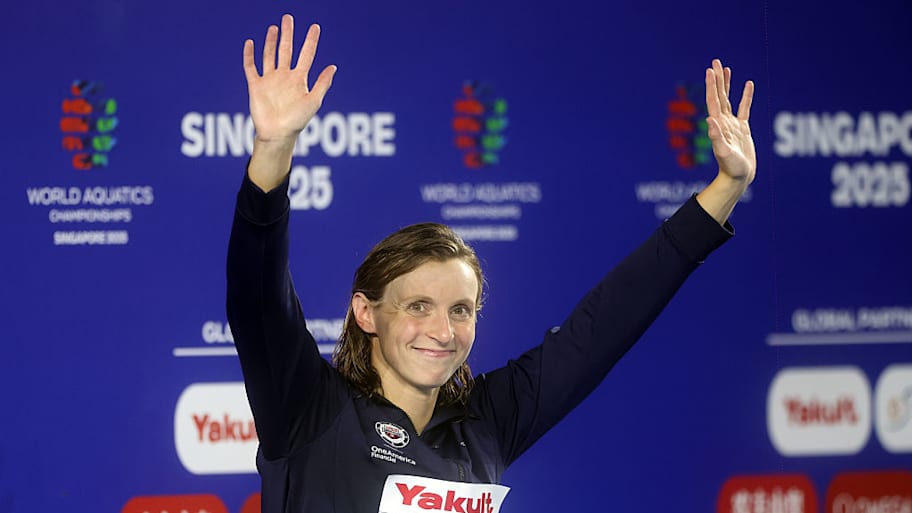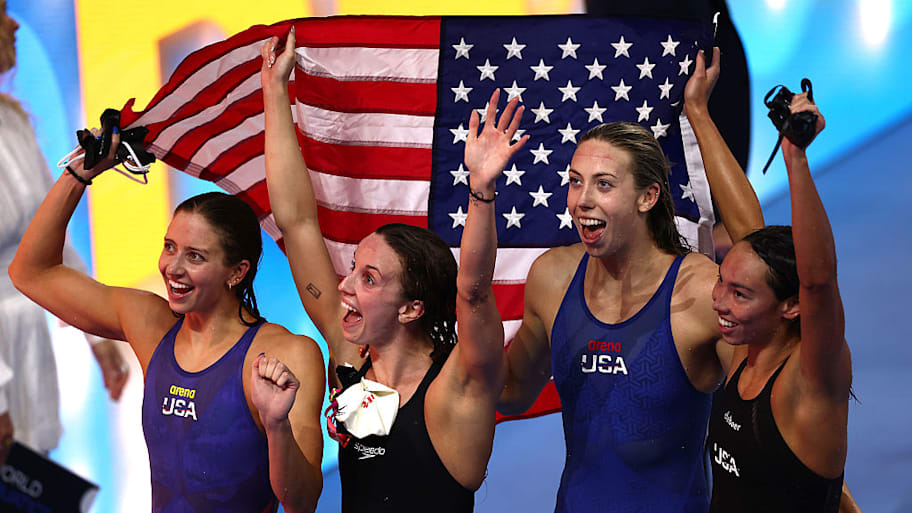The pile-on was public and prominent. It was also premature.
On Aug. 1, during the latter stages of a bizarre and challenging World Aquatics Championships in Singapore, all-time great Ryan Lochte declared the death of USA Swimming on Instagram. Lochte posted a picture of a tombstone that listed a lifespan of 1980–2025. (America was extremely successful internationally long before 1980, and in fact boycotted the Moscow Olympics that year. But nobody is seeking out Lochte for history lessons.)
Then, Michael Phelps, the greatest swimmer of them all, amplified Lochte’s post and asked, “Is this the wake-up call USA Swimming needed? Let’s find out.” A day later, NBC analyst Rowdy Gaines weighed in via an Associated Press story, suggesting a sense of “entitlement” within the ranks of the U.S. athletes.
Up to that point, much of the criticism seemed valid, albeit lacking in important context. (Specifically, nearly the entire team had been sick with what was labeled “acute gastroenteritis” for most of the week.) But here’s what happened thereafter:
- Katie Ledecky won the greatest 800-meter freestyle race ever contested, beating back two fierce challengers to maintain her lifetime undefeated streak in that race at major international competitions. She exited Singapore with two golds, one silver and one bronze.
- Gretchen Walsh won a gold medal in the 50 butterfly, her second gold of the meet.
- The U.S. mixed 400-meter freestyle relay team won gold and broke the world record. Australia, which won both the men’s and women’s 400 free relays, didn’t even make the eight-team final.
- The women’s 400 medley relay won gold and broke the world record. That gave the U.S. two of the three world records set in a fairly slow meet.
- Americans won four other medals over the final two days of the meet.
By the time it was over, reports of the U.S. demise were greatly exaggerated. Things are not great in some key areas, but the program is not dead.
After being decimated by illness, the U.S. once again won the most gold medals (nine) and the most total medals (29) of any country. This was an improvement over the disaster at 2023 Worlds in Fukuoka, Japan, when Australia nearly doubled the American gold-medal count, 13–7. It was on par with the American performance last year at the Paris Olympics—which was underwhelming, but also not encumbered by rampant illness.
New USA Swimming national director Greg Meehan tells Sports Illustrated that about 85% of the team in Singapore was sick, and a “good percentage” of those were “hit hard.” There was widespread weight loss, with many swimmers losing around five percent of their body weight—a major problem for such lean athletes. There were at least eight American scratches by prominent swimmers in potential medal-winning races.
“The team persevered and was really tough,” says Meehan, who took the job in late March. “Hard to describe how bad it was. Those who didn’t get sick were really good.”
That said, the issues USA Swimming faces run deeper and start higher—at the very top, in fact. The organization hasn’t had a full-time CEO in nearly a year, since forcing Tim Hinchey out shortly after Paris. Delaware athletic director Chrissi Rawak was hired for the position in February, and it quickly became a complete debacle. Rawak withdrew from the post days later, after a SafeSport complaint was filed pertaining to Rawak’s tenure as a Michigan assistant coach from 1988 to ‘92. Five months later, there is still no one in charge.
Faulty planning from USA Swimming leadership likely contributed to the team’s rampant illness. Choosing Thailand for the pre-meet training camp—a decision made years in advance—was an all-time bad idea from a food and practice standpoint. The training pool was outdoors during that country’s rainy season, which impacted workouts. Condé Nast Traveler says “the months to avoid are July and August,” and USA Swimming elected to hunker down there in July. Brilliant.
Meehan said USA Swimming will adjust its process for picking future training locations in advance of major international meets, looking for “more protected training environments.” The next round of sites may not be as Instagram-friendly for the athletes, but they will have a better chance of getting important meet prep done and staying healthy.
Beyond that, there is no hiding the fact that the competitive product simply has to get better leading up to the Los Angeles Olympics in 2028. Much like the U.S. Olympic basketball teams, nothing less than excellence and dominance are expected—even if the world is improving around the Americans. It’s time to meet expectations, not run from them.
The U.S. women’s team is in great hands, with a core group of superstars in Ledecky, Gretchen Walsh, Regan Smith, Torri Huske and Kate Douglass (who was nothing short of heroic in Singapore). Those five should win multiple individual medals for the next three years while forming the nucleus of dominant relays. There also is a secondary group of veterans on the women’s side that adds depth and medal possibilities.

The men’s team is a mess. Even with the team illness factored in, it’s hard to excuse a world championships performance in which the American men won zero medals in the 100 butterfly, 100 backstroke and 100 breaststroke. The U.S. men were also shut out in the 50s of those strokes, a blanking that takes on added weight now that those events will be contested in the Olympics for the first time in ’28.
Those embarrassments could resonate with some mainstays from previous international teams who sat out these world championships—backstroker Ryan Murphy, butterflyer/freestyle sprinter Caeleb Dressel and breaststroker Nic Fink. They made up 75% of many recent American relays, and their absences were felt here. All three are now fathers, and their interest in competing may have waned—but a return to competition from any or all of them would be welcomed.
Right now, the U.S. has three cornerstone freestylers: Jack Alexy in the sprints, Luke Hobson in the 200 and Bobby Finke in the distance events. More are still needed. And clearly there are holes in the other strokes.
One option—for both the men’s and women’s teams—is to empower Meehan as a coach while also serving as the overall leader of the national competitive program. He won NCAA championships at Stanford and coached a lot of Olympic medalists there; why not have him form a dedicated group of swimmers at the Olympic Training Center in Colorado Springs that is focused on international competition?
That might conflict with some of the college teams that form the backbone of American swimming success. But if the goal is to build the American roster for 2028, it might be the best path.
In particular, a Meehan-led individual medley training group could snap the Americans out of a long plateau—the U.S. records in the men’s 400 IM and 200 IM date to 2008 and ‘11, respectively, and the women’s records in those events date to ‘08 and ‘09. Those events are currently owned by Frenchman Leon Marchand on the men’s side and Canadian Summer McIntosh on the women’s side. While they will be difficult to dethrone, America should at least have multiple challengers who can give them a race.
So, yes, there is a lot of work to do. But it’s 2025, not ‘27. The doom and despair, outrage and umbrage, panic and petulance were premature last week. Let’s see what a healthy American team with better leadership can do over the next three years.
More Olympics on Sports Illustrated
This article was originally published on www.si.com as USA Swimming Criticism Was Premature, but Something Must Change Before 2028 Olympics.
